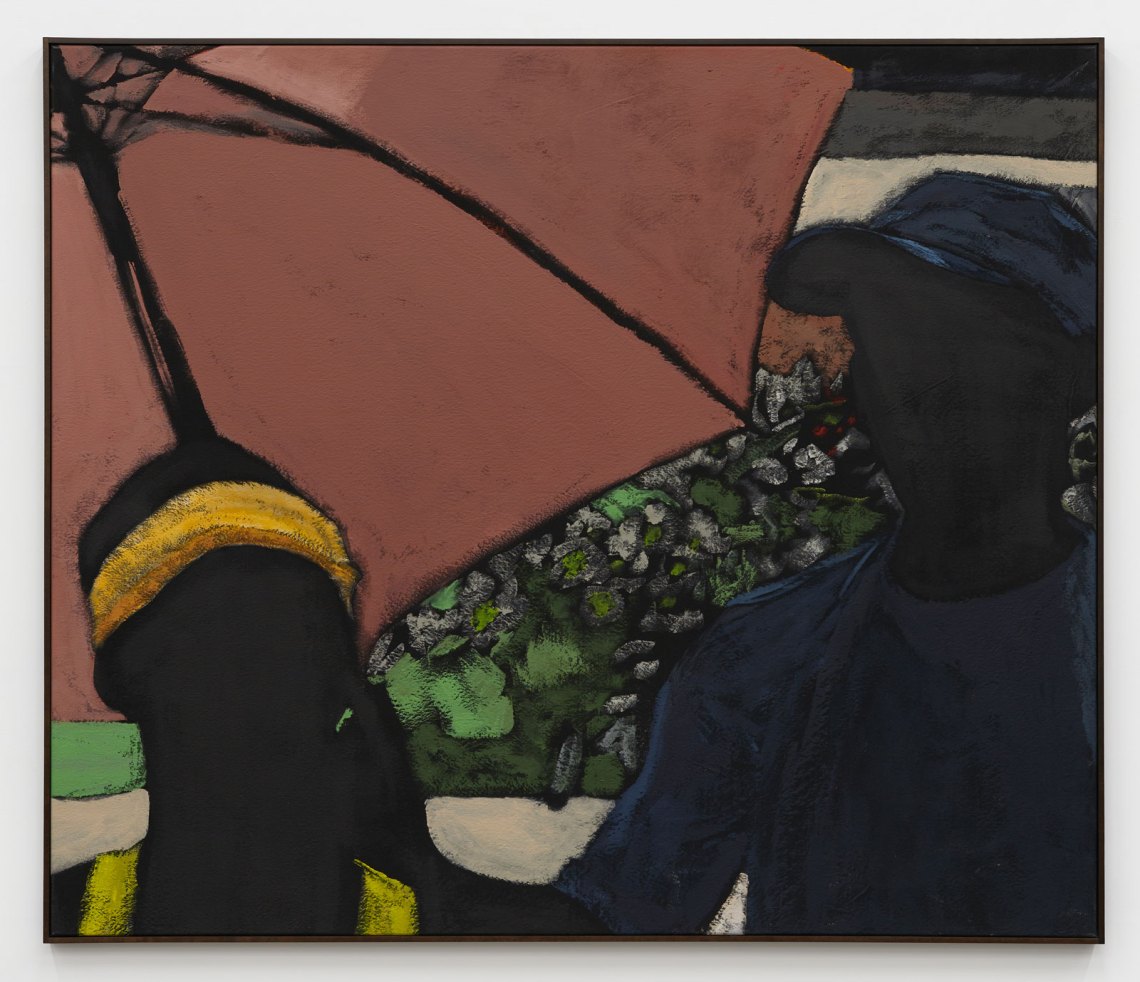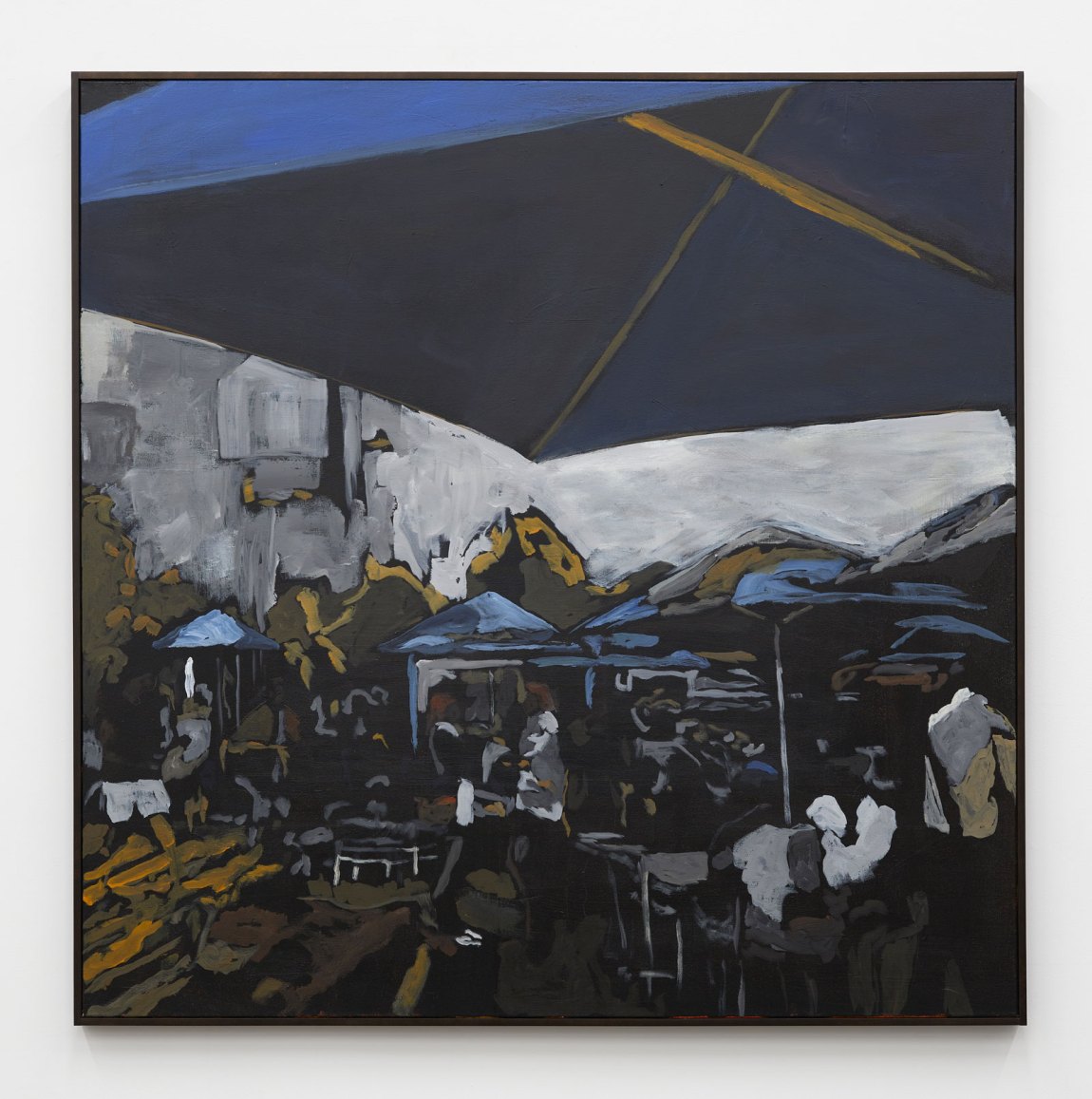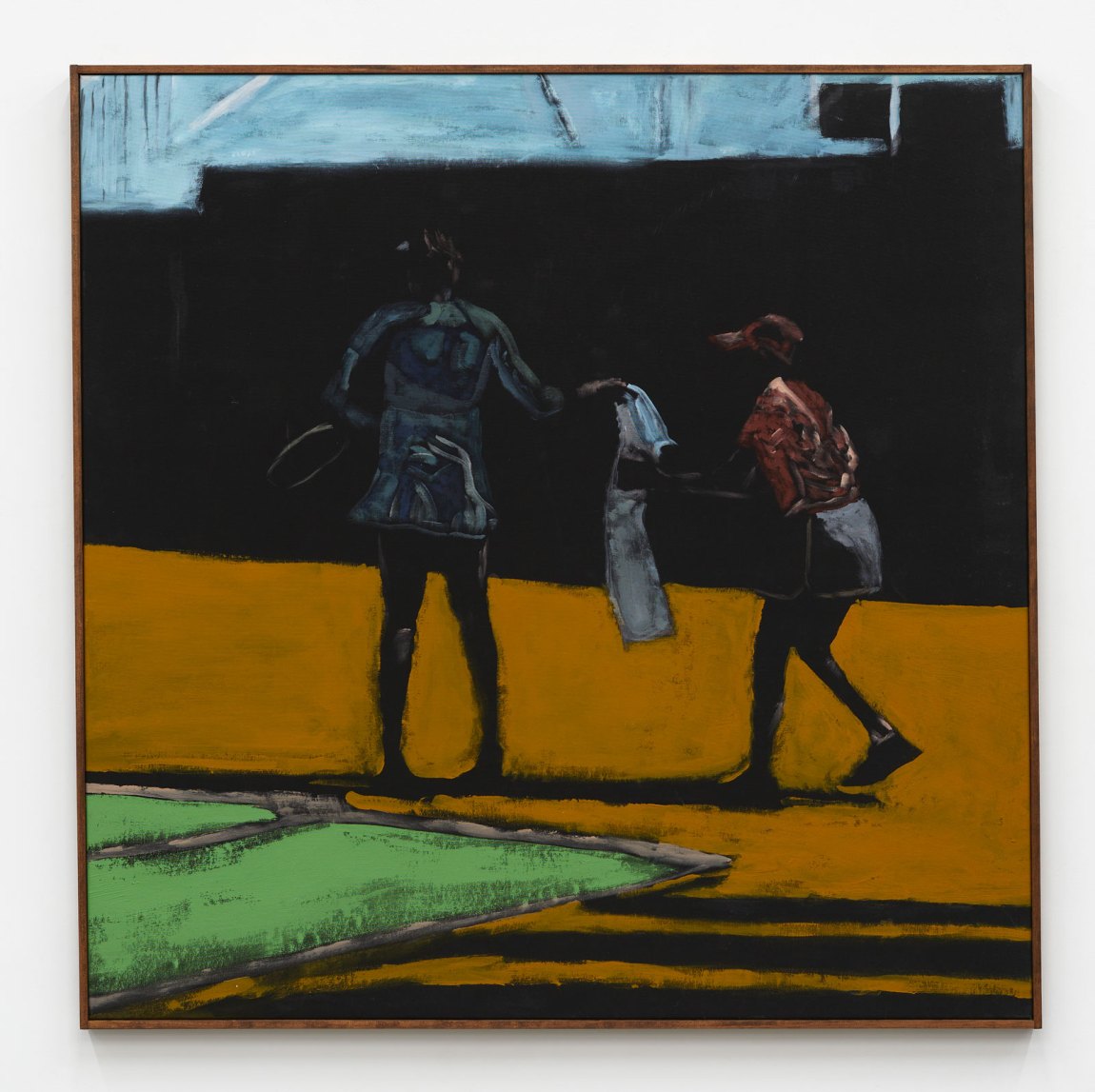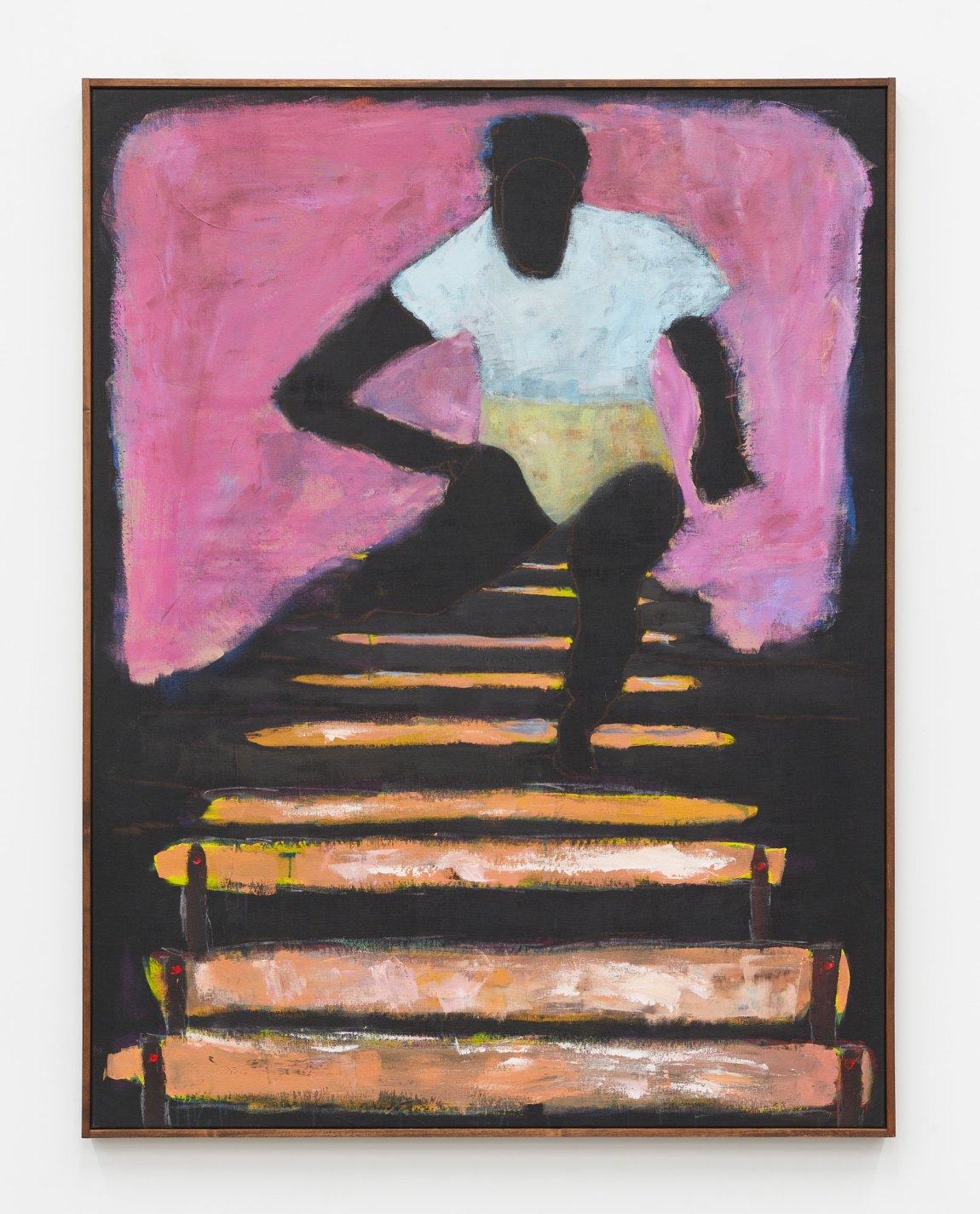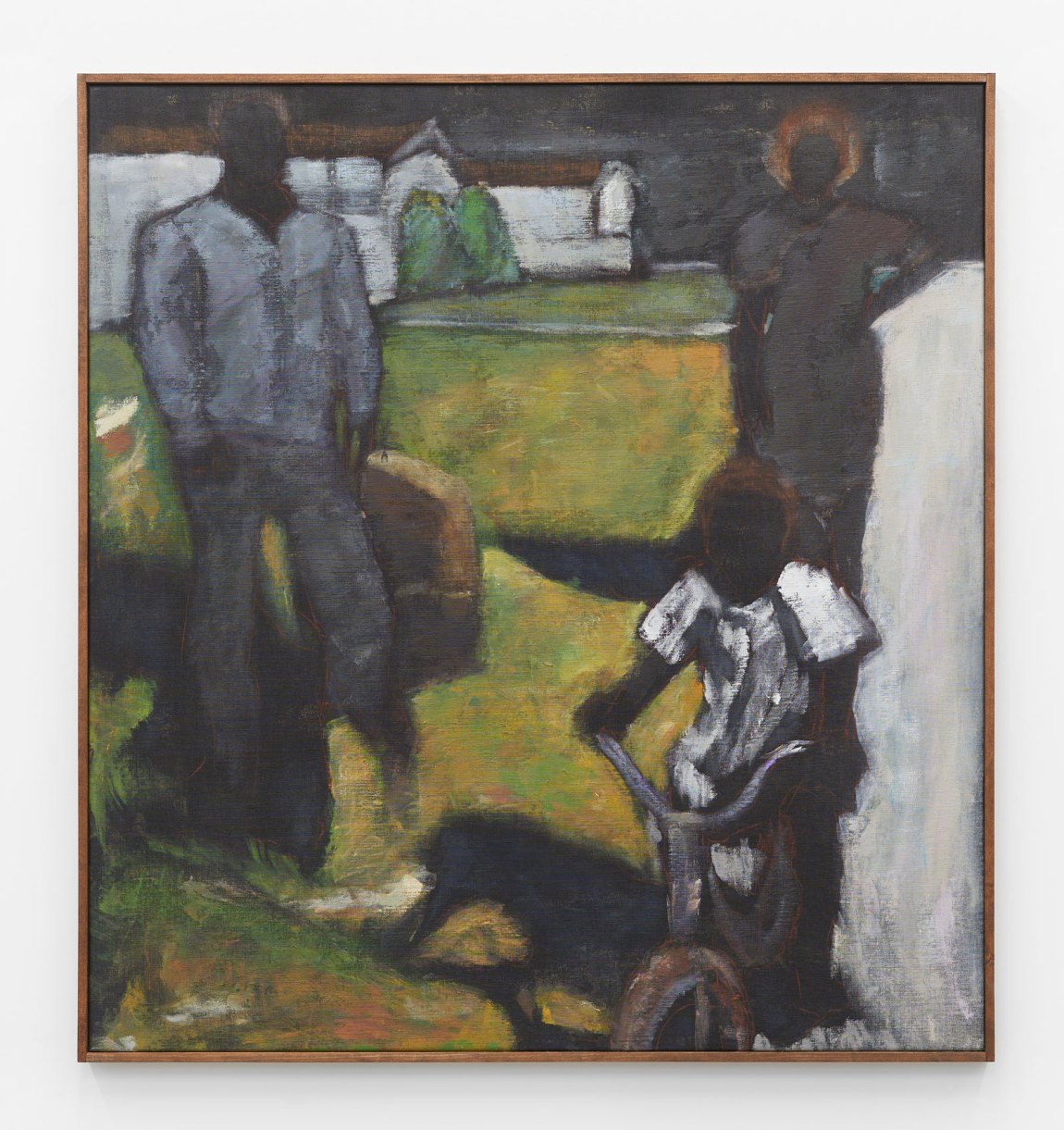Reggie Burrows Hodges begins by painting a raw canvas black. Then he paints his figures and their atmosphere on top of that. His hand is everywhere in his work, in control but not controlling. Shall we call Hodges’s work controlled bleeding? While Color Field painters such as Helen Frankenthaler, Morris Louis, and the like managed their paint by splashing color here and there, their project was different from Hodges’s in a number of ways, including their use of color. While today we look on those distinguished Color Field paintings for the joy they express about physicality, the irrepressible eye, and a relative lack of fear when it comes to the decorative, there are, in these artists’ wonderfully gestural work, some shortcomings. Such as their use, or lack of use, of the color black, a hue that is of the utmost importance to Hodges, who has said: “I start with a black ground [as a way] of dealing with blackness’s totality. I’m painting an environment in which the figures emerge from negative space….If you see my paintings in person, you’ll look at the depth.”
Black Ground: In Pursuit (2019) is emblematic of Hodges’s equating blackness not only with depth of field, but depth of person. What we see in this work: two partial figures, perhaps both male, standing or sitting under an umbrella. The smaller figure sports a yellow headband; the headband echoes the yellow in the smaller figure’s T-shirt straps. The taller figure sports a cap. Behind both figures there’s a hedge; the sun dapples the green leaves. Those are the general outlines of the painting. What we feel about it is also based on what we cannot see, which is to say Hodges’s subjects’ faces, and whether the older man is holding the umbrella over the younger person’s head—a potential gesture of such tenderness and concern that I had to look away from the image at first. Are they in shadow because of the umbrella, or because of the shadows that collect on our faces and bodies when we step outside of bright sunlight before our eyes adjust? Is that the moment Hodges is capturing here as well, the move from darkness to light? Hodges’s characters—all of whom I think of as characters in a giant narrative about American life as it’s played out in games and loneliness—often don’t have physiognomies with discernible features. Their faces are a black plane. Does this make them ghosts? Are we ghosts now, as we wait for change in this ill world of the dying, framed by loneliness?
A fan of Milton Avery’s work, Hodges, like the legendary colorist, looks for, and renders, his figures’ essence as it lives and breathes in the political. In 1934, Avery painted The Nursemaid. Here, a brown-skinned woman talks to another dark figure. The nursemaid, dressed all in white, holds the hand of a pink, or presumably white, child. As usual, Avery isn’t concentrating on the figures’ faces; he’s interested in their postures, and the strange echo of the nursemaid’s hands in those of her charge. It’s the hands, and the bodies as shapes made by paint, that are Avery’s focus, along with how the figures are alone together. To all of this, Hodges adds all that wonderful, unequivocal blackness.
*
Born in 1965, Hodges was raised partly in Los Angeles; as a teenager he moved first to New York, and then Washington, D.C., with his father, an entrepreneur who spent a great deal of time trying to shield his artistically inclined son from the challenges of racism without closing the world off to him.
By 1986, Hodges was a student at the University of Kansas, where he played tennis on scholarship, majored in theater and film, and did coursework in African American studies. After graduating, he settled in New York, where he focused on music. From 1995 to 2010, he wrote songs for, and toured with, Trumystic, a dub rock group. In 2000, Hodges relocated to Vermont, before settling in Maine in 2008, where he now lives.
Despite or because of his peripatetic lifestyle, art-making has always been a constant for Hodges. He recalled from his childhood that his father had a drafting table young Reggie could share, but was warned to be careful with. So saying, Hodges’s father instilled in his son a kind of reverence for workspaces and, by extension, the real stuff that goes into creation—such as discipline. These are extraordinarily disciplined paintings, and I’m trying to remember, just now, if that was one of the qualities that first struck me about them. After I got over my own memories, or felt free enough to share them with Hodges’s paintings, I could see, at last, the discernment and velocity framing his own memories, his own images.
Advertisement
I think Hodges’s In the Service of Others: Consistency (2019) was the first of his larger paintings I ever saw. I remember feeling frightened in its presence; looking at the image was like standing on the brink of a mass I could not recognize. Were they mountains? Was it sea? Was it air? After a while I recognized the scene—a relatively “realistic” view of folks on a tennis court. One person is being handed a towel. But then the cinematic creepiness of the image—what was under that surface seen through the seen through the skein of darkness?—compelled me to keep looking because I was afraid of it. How often can we say that about a work in our age of aesthetic transparency, in a world that rushes to categorize who we are and why, where everyone has taken some version of art history powered by Google?
For a time, I clung to Hodges’s details as a way of feeling I had control over the work, and not the other way around. For a time, I stood away from Hodges’s art so as not to be taken over by it. My eye and “I” could not find an area in the canvas where I could stand in collaboration with the artist. And yet, as much as In the Service of Others: Consistency frightened me, I could not look away. The artist was in control of my fears, as much as my pleasure. I could not look away because of the blackness. Blackness dominated the scene, and it was of a kind I had not seen before; it seemed to sink into the linen of the canvas, and then bleed out a little bit, and stain, but to be, at the same time, controlled by the artist’s hand with all its steady gestures.
*
In his lovely essay about the painter Beauford Delaney, the artist’s close friend James Baldwin describes how Delaney taught the writer to see the color black. Baldwin writes:
Though black had been described to me as the absence of light, it became very clear to me that if this were true, we would never have been able to see the colour; black: the light is trapped in it and struggles upward, rather like that grass pushing upward through the cement.
What Hodges’s characters are pushing up past, and through: the idea that blackness is “heavy,” politically, artistically, and otherwise. When I look at the ambitious and devastating Intersection of Color: Garden (2019), I see the garden, a community space, but thankfully I don’t see sociology framing it—that is, the garden as a “poor” space for the disenfranchised to gather and create a communal haven separate and away from whitey. Rather, the painting is an exploration, first and foremost, of that most elemental of the artist’s endeavors: paint. What does this color look like next to that color? And if I build a world from the ground up, what does the ground look like in comparison to the sky? Black earth, black figures, a gray and white sky.
What this teaches us about Hodges’s painting, in particular, is that he does admit the viewer into his work, and wholeheartedly, once you get past your preconceptions about blackness, and what it’s supposed to mean, either as “pure” paint, or as a figure. While Kerry James Marshall might come to mind in works like Hurdling: Sky Blue (2020), the comparison is cosmetic: Kerry means for his super-realistic figures, faces, and situations to be seen for what they are; while Hodges is intent on starting another conversation altogether, one that begins and ends with the shapes he is making, and allowing you to make with him, if you let your eye roam while staying close to the canvas. Seeing as an event.
Sometimes, when I look at Hodges’s work, I think about black mirrors. Black infinity mirrors. I read once that artists ranging from Gauguin to Renoir had them and, sometimes, at the end of a long spell of work, they would look into the mirror to refresh their eyes; it was a break from looking so intensely at color. Hodges’s black has a transfixing power as well, and I wonder if, when he paints a white canvas black as a way of beginning, if blackness has a similarly transfixing effect on him as well, and, if it does, does that lead to his paintings, which are dreams that are so awake with real life?
Advertisement
Hodges’s paintings are not only recovered memories about growing up in Los Angeles, and then being an athlete, and then becoming a man and an artist, they are also memories of familial connection, or a way of thinking about connecting with family. In Big We’ll (2020) a little boy is taking off or trying to take off on his Big Wheel, while an adult man and woman stand nearby, protective and watching. The woman’s hand is resting on her hip: it’s a gesture that conveys so much about Black female being in a hostile world: my hand is resting on my hip for now, but that very hand can be in your mouth in a minute if you mess with this scene framed by innocence. The surrounding air is thick with possibility, warning, the remembered and felt concerns of Black parents, wonder. Perhaps the older man sees himself in that little boy, and in seeing that child take off into the world, there is so much he could say about its dangers—the older figure’s posture, like many of the men in Hodges’s stories, is a kind of shield and portal between that young person and the rest of the world—but now is the time for silence and watchfulness as the child, intent on discovering the universe for himself, takes off down a road to find his own wonder, and the school that will shelter him as he nourishes his own ideas about love, color, space, and the imagination.


